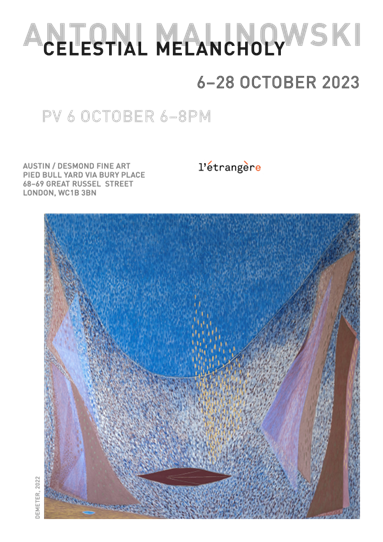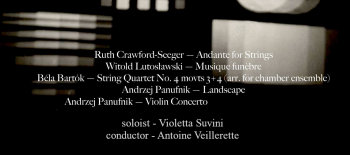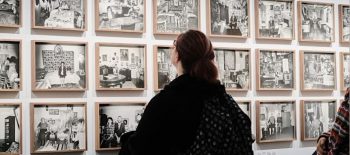6th – 28th October, Austin/ Desmond Fine Art, Pied Bull Yard, 68-69 Great Russel Street, London

An exhibition of new paintings by established London-based Polish painter Antoni Malinowski.
Created during the pandemic, the paintings resonate with memories and experiences of places visited or imagined by the artist, into which the viewer is invited to enter as spaces for meditative reflection.
Essentially an abstract painter, Malinowski has recently included representational pictorial references in his work. Chairs, used for the first time in Sleepwalker Orchard in 2021, are symbolic of human presence and absence, evoking poignant associations of memory and loss, or the hope of return; themes which have been at the heart of Malinowski’s work since the isolation times of the pandemic.
He explains: “When I first saw Pina Bausch’s Café Müller I was really struck by all those scenes with chairs. Her character was a sleepwalker, and in order to get the right movement-tension, she choreographed a way of walking through the space full of chairs, with her eyes closed, but with her pupils looking straight ahead. This is an extremely difficult and uncomfortable thing to do — normally when we close our eyes the pupils go down. Yet, this tiny alteration so influenced the movement of her entire body that it became uniquely tense and evocative.”
Chromatic poignancy is at the heart of Malinowski’s paintings in what he describes as a light- sensitive pictorial instability.
His use of interference pigments with their light bending and scattering properties echo similar strategies in pre-Renaissance gold paintings and mosaics. T
he new pigments that he experiments with create subtle shifts of flickering colour as accumulations of brushstrokes are built up across the surface of the canvas, hovering and seeping into contrasting backgrounds.
The chromatic shifts encourage the viewer to shift their own viewpoint in what becomes a performative spatial experience of the work. Despite these subtle pictorial interventions, Malinowski’s paintings resist any simple narrative interpretation and invite the viewer to meditative contemplation on colour and light.
As Sarah Kent observed in her review of Malinowski’s exhibition at Camden Arts Centre (1997): “… rather than attempt identification, one is happy to swim over or be soaked in by the inviting islands of warm colour. Most pervasive is one’s awareness of the calm intelligence that created these images which resonate with so many associations yet are limited by none of them. Wonderful.”
Malinowski fascination with light, pigment, movement, time and the dynamic potential between pictorial and architectural spaces is rooted in his investigation of ancient Roman wall frescoes which began as an Abbey Scholar at the British School at Rome. He was particularly struck by the use of intense pigments, like the vivid vermillion red deployed in the Villa of the Mysteries near Pompeii (60-70 BCE) – a colour which has become a constant thread in his work.
Malinowski’s painterly practice is not confined to reviving ancient techniques however and he has gone on to research and develop work which utilizes both historical and contemporary pigments with a focus on their specific light-reflecting properties. Through his technique of layering pigments of varying light reflectance, he seeks a way of enriching and intensifying form and the experience of the space through the colour.
Known for his immersive, architectural collaborations, including several commisions with the architects Haworth Tompkins, Malinowski’s large-scale projects include the Royal Court Theatre in London (2000) and the transformation of a drum-shaped wall using traditional powdered pigments. This was followed by the Donmar Theatre studio space staircase, London (2014) and the Everyman Theatre Liverpool, which won the 2014 Stirling Prize.
Antoni Malinowski (B, Poland 1955, lives and works in London) studied at the Academy of Fine Arts, Warsaw and Chelsea College of Art in London.
Malinowski’s painting/drawing installations include: Placed/Displaced at Chisenhale Gallery in London, 1986, Wall Drawing for RIBA, London 1998, Echoing the Pavilion, De La Warr Pavilion, Bexhill on Sea. Bridging Lines, Venice, (shown during the Architectural Venice Biennale, 2004), Bridging Lines, Milan at Studio Giangalezzo Visconti and Assab One, Milan, 2005 and Bridging Colours, Gallery 175, Seoul, South Korea, 2010. Major Solo exhibitions include, Camden Arts Centre (1997) Light Triggered (Ragged School Museum, London, 2018) and Almost Seen (Assab One, Milan, 2018).
Malinowki’s work has been widely exhibited internationally and is in many private and public collections including Tate, London, British Council, Arts Council and Nat West Group Art Collection.
More details about the exhibition:
More about Antoni Malinowski:



